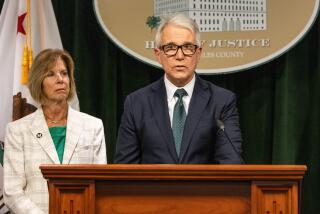Witness Says Police Coerced Him to Lie
The key witness in a murder case currently awaiting trial in Superior Court has told The Times that he falsely identified the alleged killer after being coerced by an anti-gang officer and a homicide detective from the Los Angeles Police Department’s Rampart Division.
Evelio “Rudy” Carrillo said in an interview that he told both the officer and the detective that he knew nothing of the Dec. 4, 1998, drive-by shooting they were investigating. Nonetheless, he said, the officers showed him a “six-pack” photo array that contained a picture of Jose Luis Oliverria, the man police suspect of the slaying. The picture had a circle around it, Carrillo said.
The officers, he said, “were trying to give me a hint . . . saying that was him, you know, to pick him out.” Carrillo, who provided The Times with a sworn declaration, said that officers implied that failure to cooperate would result in his prosecution for other alleged crimes.
The homicide detective, who denies any wrongdoing, was transferred to an auto theft detail after the district attorney’s office complained to the LAPD about his testimony during a preliminary hearing in the case in which he falsely stated that he had been at a hospital and interviewed witnesses, when in fact he had been on vacation.
The detective’s false testimony, coupled with Carrillo’s allegations, raises troubling questions about whether corruption continues to flourish in the LAPD, even as Chief Bernard C. Parks wages a campaign to root it out. Critics point to the case as a prime example of how prosecutors in Los Angeles’ criminal justice system are willing to move forward with the weakest of cases, and are able to do so because of lax judicial scrutiny.
Los Angeles County Public Defender Michael P. Judge said he was outraged that Superior Court Judge Glenette Blackwell held Oliverria to answer on the murder charge, despite the detective’s admittedly false testimony.
“It’s an inexplicably bizarre performance by a judge who failed to exercise any prudence, common sense or judgment,” Judge said.
He said he was less surprised by the detective’s false testimony and the alleged misconduct during the investigation.
“We can deduce from what has been revealed in the last six months that this type of misbehavior by the police is far more prevalent than anyone has previously imagined,” Judge said. “I think this compels us to conclude that it is systemic.”
Blackwell said she could not recall details of the case and declined further comment.
The case in question revolves around the slaying of 19-year-old Wilber Escobar.
According to the police account of the killing, culled from numerous investigative documents obtained by The Times, Escobar was in the front passenger seat of a car at the intersection of Washington Boulevard and New England Avenue when another car pulled up alongside and someone in it opened fire about 11:30 p.m.
Escobar, identified as a South Side Kings gang member, died shortly after midnight at California Hospital.
The shooter, who witnesses said was the front-seat passenger in a large gray two-door sedan, was described as a male Latino with a shaved head and a black mustache, police records show. The shooting was deemed gang-related.
Ten weeks later, homicide detectives had few clues, according to an Unsolved Murder Investigation Progress Report dated Feb. 15, 1999.
The case languished for another month, according to police documents. But then came a major--and unexpected--break.
Rampart CRASH Officers Dustin Sclater and Ross Hay were following up on a weeks-old robbery in which three gang members were allegedly held at gunpoint and forced to hand over a dollar and a six-pack of beer.
According to the official account, the officers spotted one of the victims of the alleged robbery playing a video game at a liquor store on Mar. 18, 1999. The alleged victim, Rudy Carrillo, told the officers he would be able to identify one of the robbers, whom he said he recognized as a member of the Drifters gang.
On the way to the station to look at pictures, police said, Carrillo suddenly recalled that the man who robbed him also had pulled a gun on him minutes before a shooting three months earlier at the intersection of New England and Washington. The man--a passenger in an older-model gray car--drove off, leaving Carrillo unharmed, after Carrillo told him he knew somebody from the man’s gang. Moments later, Carrillo heard gunfire and looked over his shoulder to see the gray car next to another. The occupants were apparently engaged in a gunfight, Carrillo said.
At the Rampart detective’s station, Carrillo picked Jose Luis Oliverria, a reputed Drifters gang member with a lengthy criminal record, out of an array of photos. According to police, Carrillo fingered Oliverria as the man who had robbed him and then held him at gunpoint just before the shooting on Dec. 4, 1998.
After that, police documents show, Oliverria became the prime suspect. Ludwin Escobar, who was with his brother, Wilber, when Wilber was killed, tentatively picked Oliverria out of a photo array, but said that he could not be sure without seeing him in person. Oliverria, who maintains that he was in Mexico at the time of the killing, was charged with Escobar’s murder last April, shortly after he was caught attempting to illegally reenter the United States.
In the Times interview, Carrillo refuted nearly every aspect of the police officers’ version of events.
He said that when he saw Officers Sclater and Hay last March they said they wanted to talk to him, not the other way around.
“He [Sclater] said they were looking for me for something I did a year and a half ago,” Carrillo recalled. “He said I owed them one.”
When they got to the station, Carrillo said, the officer began questioning him about Escobar’s murder. He insisted that he knew nothing about it.
Nonetheless, he said, the officers directed him to look at a photo “six-pack” of suspects in the slaying, at the same time repeatedly mentioning that Carrillo himself had come up in other unsolved crimes, including murder.
Carrillo said he told Sclater that he did not--could not--recognize anyone as having been involved in the shooting because he did not witness it. He told The Times that he walked past the scene about 2 a.m., on the way home from the movies but hours after the shooting.
But he said Sclater did not want to hear his denials and pressed him to make an identification. He even pointed to a circled photo of Oliverria, whose picture was also hanging out of a nearby blue binder that Carrillo recognized as an LAPD murder book.
“He told me, you don’t recognize this guy?” Carrillo recalled. “I’m like, ‘Nah.’ And he told me, ‘Yeah, well look at him again.’ ”
Carrillo said he did, in fact, recognize the man. But not from any murder. He said Oliverria, whom he knew by the moniker Night Owl, was one of the Drifters gang members who had robbed him and his friends a month earlier.
But he said the officers were far less interested in the robbery than the murder. Carrillo said he eventually relented and identified Oliverria as the man who pulled a gun on him moments before Escobar’s slaying.
“I told them everything they wanted me to tell them,” said Carrillo, who added that he gave investigators a taped and written statement.
Witnesses in gang cases frequently recant or dramatically change their stories when called to testify in court, for fear of retaliation by the defendant or fellow gang members.
In Carrillo’s case, however, he continues to maintain that Oliverria did indeed rob him, an offense that, just like the murder charge, could send the two-strike gang member to prison for life.
“I got no reason to lie,” said Carrillo, a 21-year-old aspiring artist with a lengthy arrest record who said he left gang life after the death of several close friends.
Neither Sclater nor Hay returned telephone calls from Times reporters. Neither officer has been publicly implicated in the ongoing Rampart corruption probe.
Det. John Curiel, whom Carrillo accused of coaching him through his statement the same way Sclater had, denied any impropriety.
“I have done nothing wrong. I didn’t intimidate him or anything,” Curiel said in an interview on Friday. “I loved homicide. I would not do anything to jeopardize that job.”
Some say he already has.
In a court hearing last month, Curiel testified at length about his involvement in the case on the night of Escobar’s killing.
As part of his investigation, Curiel testified, he went to the hospital on the night Escobar was shot. He met the dead man’s brother and mother, both of whom identified the victim, he said.
“What was the condition [of] Mr. Escobar when you observed him?” asked Deputy Dist. Atty. Stewart Powell during a March 6 preliminary hearing.
“He was wrapped in a white sheet and white plastic and had a tag on his toe,” Curiel responded. “I saw a bullet hole . . . in his left side toward the back.”
But during cross-examination, Deputy Public Defender Alec Henderson uncovered a problem with the detective’s testimony: It was completely false. Curiel had not gone to the hospital that night. He had not spoken with Escobar’s relatives, had not seen a body nor a bullet hole. In fact, he wasn’t working.
Henderson asked the detective how he could account for his previous testimony.
“I must have been thinking of a different case,” Curiel said.
“Did you have another [Wilber] Escobar case?” the defense attorney asked.
“No,” the detective responded.
More to Read
Sign up for Essential California
The most important California stories and recommendations in your inbox every morning.
You may occasionally receive promotional content from the Los Angeles Times.











